Deleted member 14848
Mistral
- Joined
- Aug 6, 2021
- Posts
- 2,034
- Reputation
- 4,517
Copypasta from lookism - long thread
ngl, its time for lookism to catch up on some, apparently, basic orthodontic and morphologic knowledge. felt quite painful reading up on all of this 70 years post fact and literally knowing nothing about one of the most influential factors in determining the structure of the splanchno. itt, i will provide lookism with a basic overview of the basic relations between the cranial base and the face, this will be section 1, which mostly consists of some basic illustrations and the highly basic relation between cranial base angle and prognathism. after this, in section 2, we hit some more uncharted territory when i try to dissect a study on 3d morphology of the cranial base. originally this thread was going to be a cry for help because i did not understand the particular study for shit but yet found it interesting. however, i got sidetracked into mildly understanding it. keep this in mind when reading. this goes for the entire thread, i do not pretend to be knowledgeable on the subject and am thus open for any differing interpretations, contradicting knowledge and suggestions. i post this on here for feedback. also keep in mind that i did far from write this thread in one go and did not bother to proofread at all. this might explain possible contradictions in the text
now, just for reference, this part of the skull is what we will be talking about in this thread.


section 1: cranial base angle/NSBa/NSAr/saddle angle
[there actually is a difference between cranial base angle/NSBa/Nasion-Sella-Basion and saddle angle/NSAr/Nasion-Sella-Articulare, since the Articulare and the Basion are obviously different points. doubt this matters much for our purposes though, as they lie very close to each other and show the exact same relation (the relation between posterior and anterior cranial base), means do differ but its quite irrelevant to us. the reason for the existence of these two differing measurements seems to be that the basion is sometimes difficult to identify on an x-ray, in this case, the articulare is used as a point of measurement. because most of my material referred to NSAr, i will use this along with saddle angle (because i like the ring) to refer to the cranial base angle.]
from the looks of it, cranial base angle has been researched and been found legit for decades now. this is probably in orthodontics text books. makes finding studies with clear explanations harder though, since a lot of them are probably looking to "extent beyond the basics". if all the usable material from the past 50 years looks to extent beyond the basics, its going to be hard for me to find the basics. so if i am using awkward terminology, spending way too much time on something super basic, missing something very basic, thats probably why (keep in mind that i know fuck all about biology or anatomy)
quickly summarized: reduced cranial base angle = increased "forward growth" (in lookism terms), so increased facial-protrusion in relation to the nasion (still not a medical description)
some literature citations (though this seems to be more of the same and just building upon the consensus)
another source
(very old study, probably one of the ones the entire cranial base thing started with)
since i suspect lookism in 2019 is not familiar with cephalometric landmarks, i will add some pics to better illustrate what is meant with increased SNA and SNB
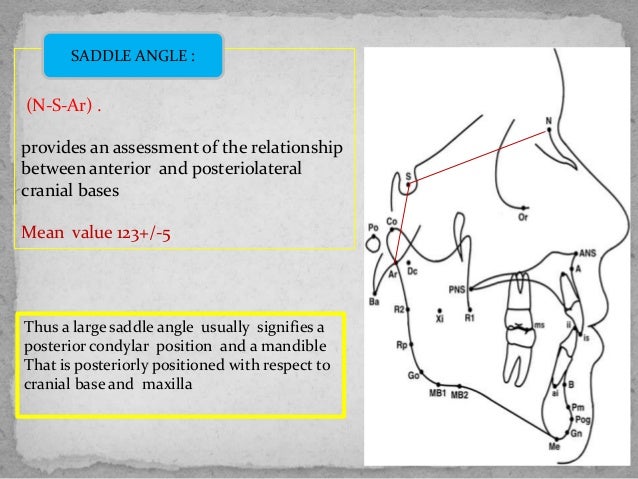
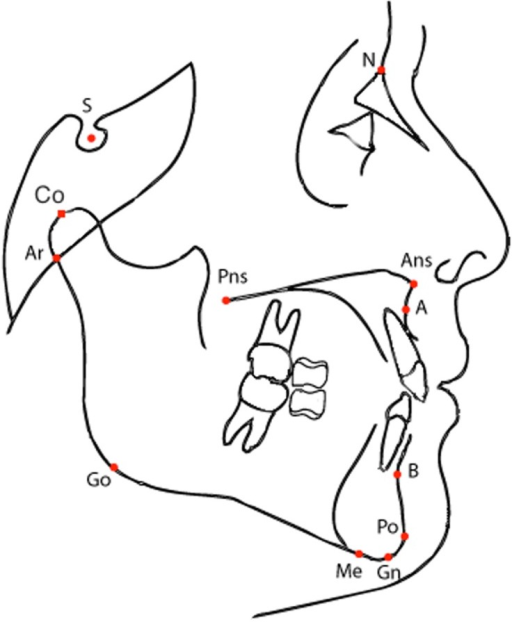
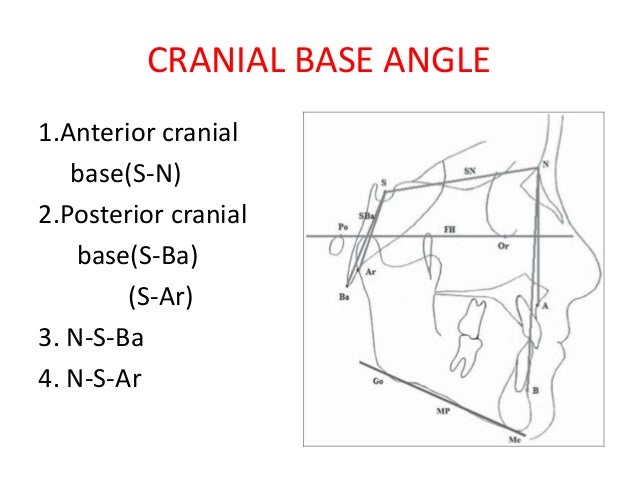
mean SNAr seems to be around 120-125 degrees looking at a bunch of studies, SD around 5-6 degrees
saddle angle differs between the genders, with females having a higher angle (and thus, on average more "recession"/retrognathism)
Yassir (2009) (shit study i know) reports female mean NSAr to be around 124 degrees, male mean to be around 122/121. seems like a bullshit stat though, as the more reputable Naini (2011) reports average NSAr values to be 125 degrees for males and 126 degrees for females with a standard deviation of 5 degrees for both. a much smaller difference. according to Naini (2011), NSBa, "the real thing", shows more average difference between the genders, with males averaging at 129 degrees (5 degree sd) and females averaging 132 degrees (4 degree sd). is this difference anatomically significant (i cant think of a better term)? no idea ngl.
now, i could cite studies confirming this for years, because, like i said, i have some six decades of orthodontic scientific literature to go back on, but i think i have "proved" enough for the standards of lookism.net. i will just leave you with a non-sourced summarizing pic of the cranial angle situation
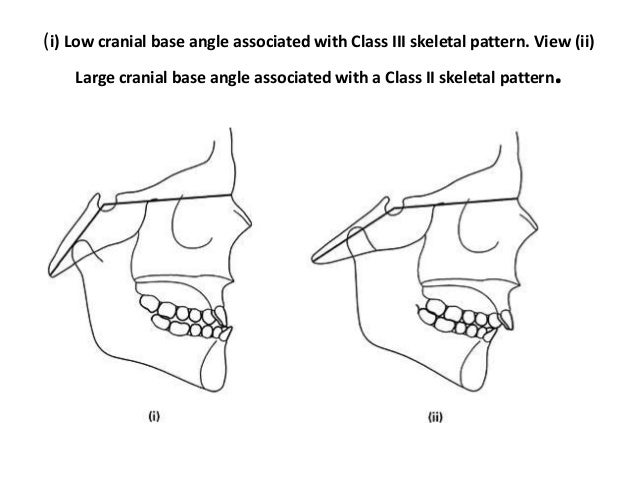
and another one from Bjork (1955)
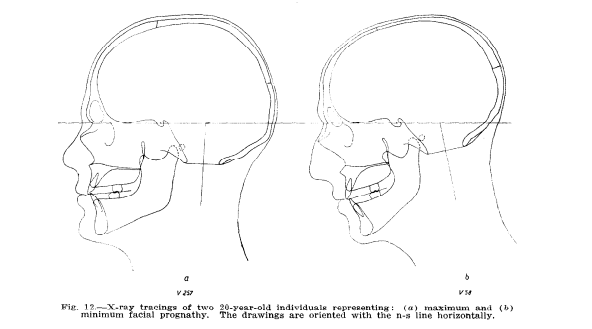
just a note: NSBa for a) is about 115, for b) its around 125. no idea whether this representative of how real faces would look like but it gives you an idea on the difference in angle vs the difference in facial appearance were talking about
Bjork (1955) also touches upon the way cranial base affects mandibular positioning and shape, which i do not find too interesting to really dive into now but i will still mention it for the sake of completeness of understanding. according to him, cranial base shape directly affects mandibular fossa positioning. a higher saddle angle would mean a more posteriorly located (look at above pic) mandibular fossa so further back tmj which would obviously affect mandibular protrusion. Enlow & Hans (1996) also state that the mandible attaches to the middle endocranial fossa, which makes the cranial base's effect on mandibular positioning quite straightforward ngl. Bjork (1955) also provides some explanation on the maxilla effect but i really do not understand it for shit ngl tbh look it up if interested pretty sure the study is freely accessible. it kind of makes intuitive sense though, just look at this pic and try to imagine NSAr decreasing and increasing with the grey part having to fit in.
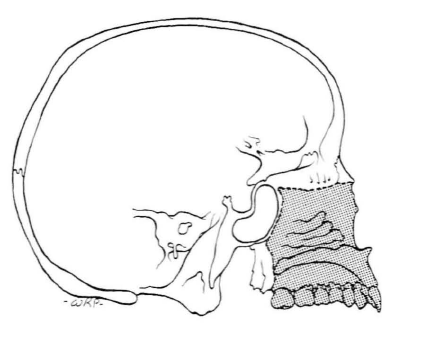
(Enlow & Hans, 1996)
i will give a little quote from Enlow and Hans (1996) for people interested in how exactly the cranial floor affects maxilla positioning.

and finally,
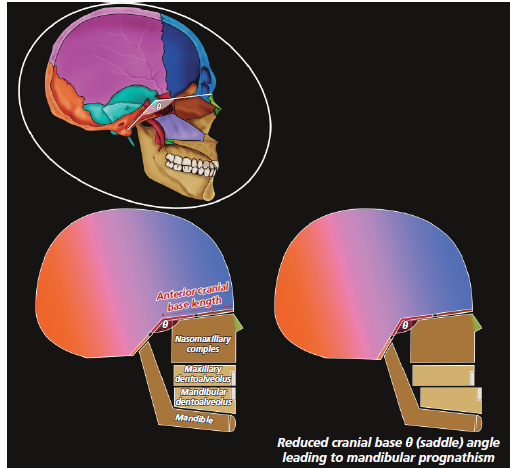
(Naini, 2011)
pic for reference:

now, in this part i will drop the 'citing multiple studies for everything'-thing for a bit. this part will probably be more highlighting just one study than it will be trying to provide everyone with a complete overview. the study in question will be
Bastir, M., & Rosas, A. (2016). Cranial base topology and basic trends in the facial evolution of Homo. Journal of human evolution, 91, 26-35.
(if i quote anything and there is nothing indicating otherwise, assume its this study i am quoting. illustrations were also taken from here, though i am not sure whether this is legal since the study is paywalled tbh)
which i found to be one of the most interesting studies i have ever read and is the reason i decided i wanted to make this post. i will be honest though, i understand fuck all on the methodology, i really do not understand shit. which is why i will mostly limit myself to reciting their conclusions (which i sometimes, being honest, also only mildly understand) and sharing their illustrations. the study seems to be paywalled, which i can bypass trough my uni but i imagine some wont be able to do. if you think i missed essential parts, if particularly interested, pm me, i might be able to help you.
i would like to start by highlighting two definitions, just to get everyone on the same line (lookism often uses these terms in a different manner)
given that i have no idea what pls even means, i will now give you some of the results. this image immediately woke me up when i saw it, legit wtf.
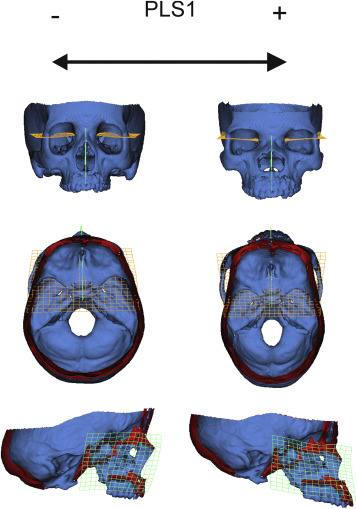
before going of into the description of what actually happens between these pictures i would like to just highlight that what i think is one of the most interesting things this pic illustrates. it is how much of an impact the lateral projection of the neurocranium in relation to splanchnocranium has on facial aesthetics. i have tried to word this before but this pic is the first time i have actually very very clearly seen the difference illustrated. look at the difference in zygomatic arch vs zygomatic lateral projection between the two, look at the difference between lateral orbital margin lateral projection and neurocranium (/temporal if you will) projection. thats what makes and breaks these skulls imo. wide sockets and a flat neuro + zygomatic arches are massive for facial aesthetics, you do not want to be able to see your zygomatic arches from a frontal, the angle with the zygoma should be 90 degrees and no more. flat neuro should be a given ideal
Spoiler
now, to get back to the point, the left skull (toward the negative scores of pls1) has a "wide and elongated middle cranial fossa with a relatively elongated anterior cranial floor" aka a long basicranium with widening in the middle. the associated facial characteristics are pretty clear, small and recessed (upper) face, "mediolaterally" (in the words of Rosas & Bastir) narrow. this is a recipe for disaster if you ask me ngl, the cranium laterally protruding so far beyond the lateral orbital wall/zygos in general with the zygomatic arches actually tilting outward is without a doubt one of the most reliable indicators of complete subhumanity.
towards the positive values of pls1 though, slayerdom seems ensured (that is, by lookism standards for midfacial aesthetics).
for people having a hard time visualizing the difference between long anterior and middle cranial fossa and a wide and a narrow mid cranial fossa, Rosas & Bastir (2016) (legit :inlove: ) have you covered no worries

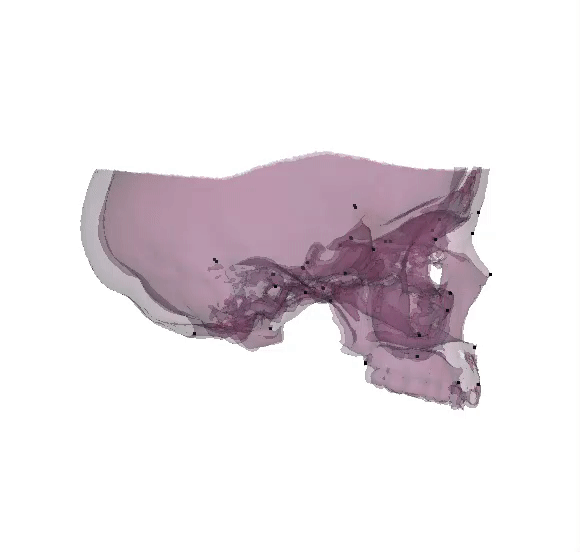
note that the saddle angle/NSAr/cranial base angle barely changes during the duration of the gif. this is all change in basicranial length and orientation/rotation. counterclockwise wise rotation of the cranial base causes midfacial recession and a narrow face in relation to the cranium. the next few points that i think are related to this upwardly rotated cranial base, are not touched upon in the study, but i am quite sure that i do detect them in the gif, they include: a higher and less defined nasion, vertically longer and more 'recessed' orbitals and a more protruding, bigger nose. maybe not interesting to the researchers, but defo interesting to me.
another thing related to changes in anterior cranial base length that seems very relevant to our purposes but was left out of the study, probably due to limitations in skulls or software, is mandibular progranthism. i actually found this only a week or something after i wrote the above part, so maybe some shit is inconsistent now, but i still thought id mention it better late than never. Naini (2011) touches upon this rather shortly, but a anterior cranial base length actually positively correlates with mandibular recession. so the negative pls1 incel with the inclined cranial base, the wide fossae and the complete lack of midfacial projection or proganthism also has a recessed mandible. this is fucked up, there is no redemption for wide cranium-cels.
now that we know what the difference between slayer and incel is, here comes the banderas part to this study
modern humans are the incels, this is basically the negative pls1 value-skull described, very sad.
the pls2 warping seems to be mostly focused on the 3d morphology of the cranial base itself (if i am reading this right). i will share the results first
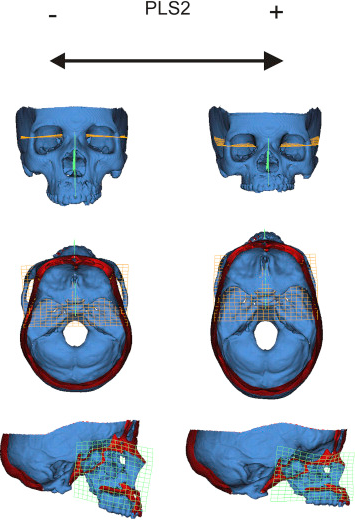
so towards the negative scores of pls2, the midline of the cranial bases is elevated "relative to the lateral parts of the greater sphenoid wing". now this is where the greater wing of sphenoid is located
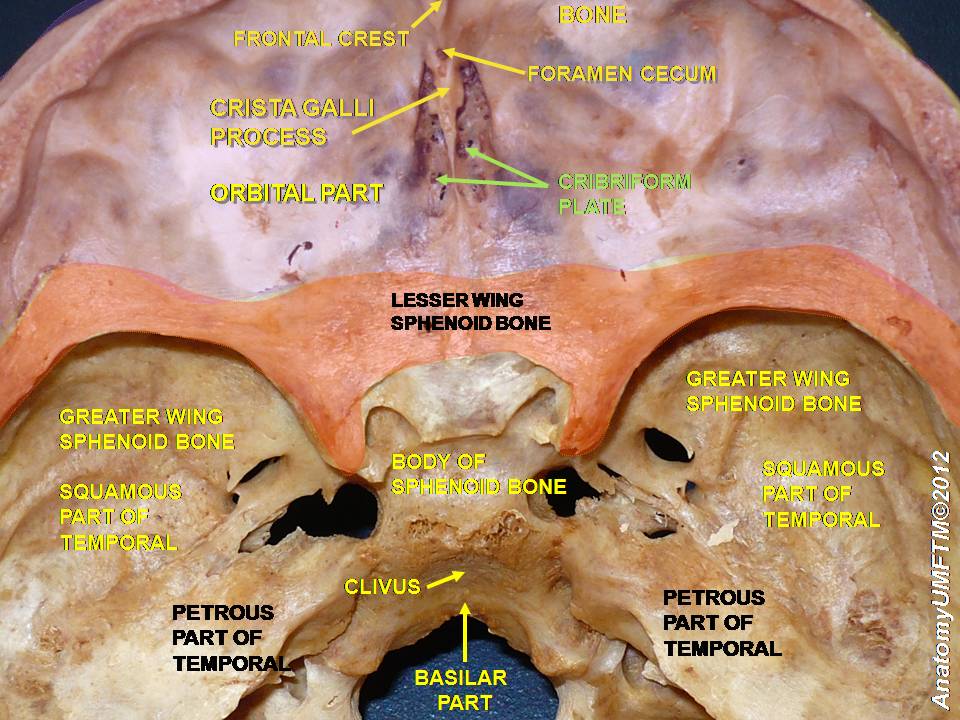
its part of the middle cranial fossa. so i am assuming they are saying the medial parts of the cranial floor (middle as well as anterior) are elevated in comparison to the more lateral parts (at least of the middle fossa). on top of this, the anterior cranial fossa (and the cribriform (duh?)) are shortened.
towards the positive scores of pls2, the entire cranial base is rotated clockwise (remember the rotations from pls1? counterclockwise rotation = subhumanity, recession, narrow face in relation to cranium, clockwise rotation = prognathism, slayer), interestingly, this leads to a reduction in vertical facial height. the width and height of the anterior cranial fossa was also reduced (keep in mind that this was not the case for the positive scores in pls1, the distance from N to A actually appears to stay rather similar to me). what went for negative scores is the opposite here, towards positive pls2 scores the lower maxilla is more horizontally oriented.
i think the biggest takeaway here is that counterclockwise wise rotation = taller face (trough taller nasal cavity), clockwise rotation = shorter face
tbh i cant make much of this, its more of an mmkay-thing than a revelation on facial patterns. the most interesting part here to me comes with the explanation of why medial cranial base elevation might mean a taller face. keep in mind that i have never followed biology, but the way it reads is that elevated medial cranial base --> more room for airways + more room for nasal cavities, which seems intuitive. now, apparently, homo sapiens tend to have smaller nasal cavities (and thus, shorter faces) than their neanderthaler and Mid-Pleistocene ancestors (who, unsurprisingly, have taller faces). according to Rosas & Bastir, the reason for this difference is that our ancestors had higher body mass, which led to extra energy and, accordingly, extra oxygen supply demands. now, assuming that there is enough variation in cranial base topology in humans to cause significant differences in nasal cavity capacity (once again, no biology) and that the body actually grows and adds mass according to its oxygen supply (seems like quite a stretch), this might mean that taller skulled humans, on average, are actually taller and broader. might be an argument for tall skull theory, though its based entirely on the speculation of some layman. just theory exercise.
the pls3 dimension seems to be focussed on the relation between cranial base and upper-midfacial projection. the discerning factor between positive and negative scores seems to be the relation of the medial part of the middle fossa to the lateral part of the middle fossa (as well as some amount of fossa width). perhaps this is hard to visualize for some, rosas & bastir have you

towards the negative values, the midline cranial base is anteriorly shifted relative to the lateral parts of the base. "The projecting anterior cranial floor in the midline is correlated with upper and midfacial projection (glabella, foramen caecum, nasion, rhinion) and a forward extension of the nasal cavity relative to the retracted zygomatic bones." the zygos are also more weakly angled
towards the positive pls3 values, its the other way around. so you have more forward zygos in relation to midline, these zygos are also angled more sharply, and a flatter upper-midface with retracted nasal cavities (so retracted midline midface)
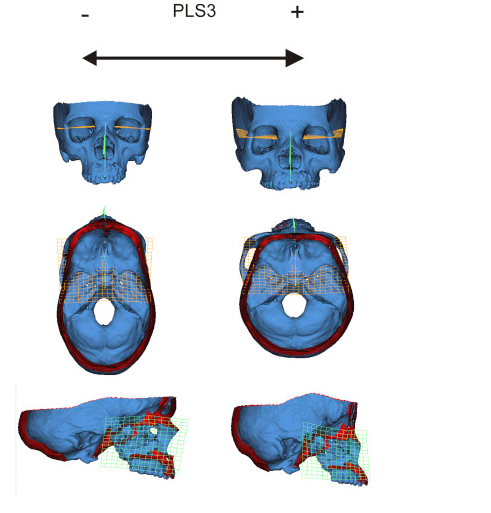
this shows us a very basic pattern: projecting zygos = flat upper face.
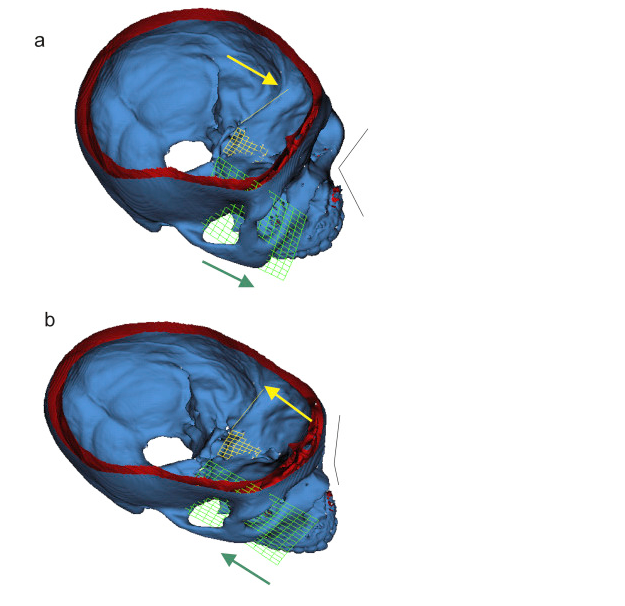
a) positive pls3
b) negative pls3
also take note of the infraorbitals and compare these to basic psl (not pls) ideas on "hunter eyes" vs "prey eyes".
while i do not think the 3d topology of the cranial base to be particularly interesting or relevant, i do think that this part of the study reveals some basic facial patterns to us. based on real life and basement observations, i would place forward nasal cavities and general upper facial projection a thousand times above muh zygo projection (in relation to the more medially located parts of the midface, that is). every once in a while someone throws up "zygomatic recession" in a rating, i honestly think its bullshit and i think that this supports it. "projecting" zygoma in relation to the rest of the face tends to mean lack of upper facial projection and just kinda looks comical irl. retracted zygoma, if accompanied by properly grown, protruding upper face/nasal cavities is ideal. another thing i find worthy to note here is the differentation in width of the cranial floor from positive pls3 to negative pls3. remember the pls1 warps? more evidence, imo, that projecting, sharp angled zygoma tend to belong to unfavorably shaped skulls. keep in mind that this is an opinion and, partly, a matter of taste, a bunch of mms and ims that get drooled all over on lookism show this blocky facial pattern that i severely dislike, though i sometimes feel that this is more motivated by a need to "fit in" than an actual aesthetic preference.
to conclude my summary of/attempt to understand this study, i would like to show a graph from the study, indicating where we, modern humans, are located in the pls dimensions (in relation to previous humanoids).
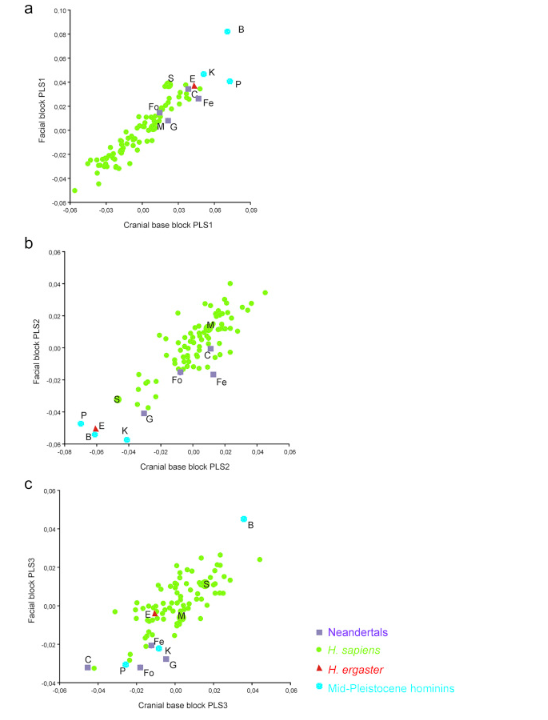
this gives you an idea of what the average skull looks like. pls1 scored seem to be centered around the middle, pls2 scores tend to be positive, while pls3 scored then seem to be more neutral with an inclination towards positive.
after reading trough a respectable amount of studies and info on the subject, i am quite convinced that the cranial base is one of, if not the leading factor in determening facial shape and proportions. like i mentioned, this is very basic theory. for example, Enlow and Hans (1996), consider it to be of the three leading regions of growth next to airway (might make a thread on this later if i feel like it as it seems to be an interesting explanatory addition to neck theory) and oral region. i wont bother extensively "proving" this to anyone, but i did think it would be nice to include some material for people to undestand exactly why this region would be so important. i might add to this section later
for the looksmaxxers:
tldr
no
references
Bastir, M., & Rosas, A. (2016). Cranial base topology and basic trends in the facial evolution of Homo. Journal of human evolution, 91, 26-35.
Bhattacharya, A., Bhatia, A., Patel, D., Mehta, N., Parekh, H., & Trivedi, R. (2014). Evaluation of relationship between cranial base angle and maxillofacial morphology in Indian population: A cephalometric study. Journal of orthodontic science, 3(3), 74.
Björk, A. (1955). Cranial base development: a follow-up x-ray study of the individual variation in growth occurring between the ages of 12 and 20 years and its relation to brain case and face development. American Journal of Orthodontics, 41(3), 198-225.
Enlow, D., & Hans, M. (1996). Essentials of facial growth (1st ed.). Ann Arbor, MI: Needham Press.
Kuroe, K., Rosas, A., & Molleson, T. (2004). Variation in the cranial base orientation and facial skeleton in dry skulls sampled from three major populations. The European Journal of Orthodontics, 26(2), 201-207.
Naini, F. B. (2011). Facial aesthetics: concepts and clinical diagnosis. John Wiley & Sons.
Yassir, Y. A. (2009). Saddle angle and its relationship with maxillary and mandibular lengths. Iraqi Orthod J, 5(1), 14-6.
i have not bothered sourcing some of the basic pictures i used. in coming to my understanding of the situation i have obviously used more literature than just what i explicitly cited.
@SansDopamine
@headsupdisplay
@Stereo
@Aurora will my oneitis be impressed you think?
@"A L P H A M A L E" for being the only person on this site to have ever mentioned cranial base and for awaring me on the existence of "Essentials of Facial Growth" by Enlow and Hans
ngl, its time for lookism to catch up on some, apparently, basic orthodontic and morphologic knowledge. felt quite painful reading up on all of this 70 years post fact and literally knowing nothing about one of the most influential factors in determining the structure of the splanchno. itt, i will provide lookism with a basic overview of the basic relations between the cranial base and the face, this will be section 1, which mostly consists of some basic illustrations and the highly basic relation between cranial base angle and prognathism. after this, in section 2, we hit some more uncharted territory when i try to dissect a study on 3d morphology of the cranial base. originally this thread was going to be a cry for help because i did not understand the particular study for shit but yet found it interesting. however, i got sidetracked into mildly understanding it. keep this in mind when reading. this goes for the entire thread, i do not pretend to be knowledgeable on the subject and am thus open for any differing interpretations, contradicting knowledge and suggestions. i post this on here for feedback. also keep in mind that i did far from write this thread in one go and did not bother to proofread at all. this might explain possible contradictions in the text
now, just for reference, this part of the skull is what we will be talking about in this thread.

section 1: cranial base angle/NSBa/NSAr/saddle angle
[there actually is a difference between cranial base angle/NSBa/Nasion-Sella-Basion and saddle angle/NSAr/Nasion-Sella-Articulare, since the Articulare and the Basion are obviously different points. doubt this matters much for our purposes though, as they lie very close to each other and show the exact same relation (the relation between posterior and anterior cranial base), means do differ but its quite irrelevant to us. the reason for the existence of these two differing measurements seems to be that the basion is sometimes difficult to identify on an x-ray, in this case, the articulare is used as a point of measurement. because most of my material referred to NSAr, i will use this along with saddle angle (because i like the ring) to refer to the cranial base angle.]
from the looks of it, cranial base angle has been researched and been found legit for decades now. this is probably in orthodontics text books. makes finding studies with clear explanations harder though, since a lot of them are probably looking to "extent beyond the basics". if all the usable material from the past 50 years looks to extent beyond the basics, its going to be hard for me to find the basics. so if i am using awkward terminology, spending way too much time on something super basic, missing something very basic, thats probably why (keep in mind that i know fuck all about biology or anatomy)
quickly summarized: reduced cranial base angle = increased "forward growth" (in lookism terms), so increased facial-protrusion in relation to the nasion (still not a medical description)
some literature citations (though this seems to be more of the same and just building upon the consensus)
so, summarized (same study):This study shows that as the cranial base angle reduces, the maxilla tends to protrude and angle SNA increases. [...] It is clear as the cranial base angle reduces, the mandible tends to protrude, and angle SNB increases Moreover, as the cranial base angle reduces, the chin tends to protrude.
[...]
It can be concluded that mandibular position is affected to a great extent by the changes in the cranial base angle. [...] The smaller the cranial base angle, the more forward the mandibular position [...] larger the cranial base angle, the more backward the position of the mandible.
[...]
Anderson and Popovich[23] found more Class-II occlusions in large cranial base angle subjects (note: Class-II occlusion = subhuman mandibular recession)
[...]
In this study subjects with most closed cranial base angle had a skeletal Class-III jaw relationship (note: this implies that mandible is more affected than maxilla, look up class-III malocclusion to see subhumanity in action. its the classic recessed midface + ridiculous chin protrusion death combo. keep this in mind before posting "NSAr < 50 degrees or death")
[...]
The maxillary length progressively increases with an increase in the cranial base angle [Table 4], thus compensating for increase in its value
Click to expand...
(Bhattacharya, Bhatia, Patel, et al., 2014)Click to expand...
- The cranial base has definite influence on the maxilla. As the cranial base angle reduces, the maxilla tends to protrude and angle SNA increases.
- The mandibular position is influenced to a greater extent by the cranial base angle than maxillary position. Cranial base angle has a determinant role in influencing the mandibular position.
- The flattening of the cranial base angle causes a clockwise rotation of the mandible.
another source
(Björk, 1955)The facial prognathism suffers an average reduction, as regards both the maxilla and the mandible, when the cranial base flattens out. [...] In retrognathic cases the cranial base is often found to by flattened.
(very old study, probably one of the ones the entire cranial base thing started with)
since i suspect lookism in 2019 is not familiar with cephalometric landmarks, i will add some pics to better illustrate what is meant with increased SNA and SNB



mean SNAr seems to be around 120-125 degrees looking at a bunch of studies, SD around 5-6 degrees
saddle angle differs between the genders, with females having a higher angle (and thus, on average more "recession"/retrognathism)
(Yassir, 2009)Females had significantly higher saddle angle than males in both classes
Yassir (2009) (shit study i know) reports female mean NSAr to be around 124 degrees, male mean to be around 122/121. seems like a bullshit stat though, as the more reputable Naini (2011) reports average NSAr values to be 125 degrees for males and 126 degrees for females with a standard deviation of 5 degrees for both. a much smaller difference. according to Naini (2011), NSBa, "the real thing", shows more average difference between the genders, with males averaging at 129 degrees (5 degree sd) and females averaging 132 degrees (4 degree sd). is this difference anatomically significant (i cant think of a better term)? no idea ngl.
now, i could cite studies confirming this for years, because, like i said, i have some six decades of orthodontic scientific literature to go back on, but i think i have "proved" enough for the standards of lookism.net. i will just leave you with a non-sourced summarizing pic of the cranial angle situation

and another one from Bjork (1955)

just a note: NSBa for a) is about 115, for b) its around 125. no idea whether this representative of how real faces would look like but it gives you an idea on the difference in angle vs the difference in facial appearance were talking about
Bjork (1955) also touches upon the way cranial base affects mandibular positioning and shape, which i do not find too interesting to really dive into now but i will still mention it for the sake of completeness of understanding. according to him, cranial base shape directly affects mandibular fossa positioning. a higher saddle angle would mean a more posteriorly located (look at above pic) mandibular fossa so further back tmj which would obviously affect mandibular protrusion. Enlow & Hans (1996) also state that the mandible attaches to the middle endocranial fossa, which makes the cranial base's effect on mandibular positioning quite straightforward ngl. Bjork (1955) also provides some explanation on the maxilla effect but i really do not understand it for shit ngl tbh look it up if interested pretty sure the study is freely accessible. it kind of makes intuitive sense though, just look at this pic and try to imagine NSAr decreasing and increasing with the grey part having to fit in.

(Enlow & Hans, 1996)
i will give a little quote from Enlow and Hans (1996) for people interested in how exactly the cranial floor affects maxilla positioning.
to illustrate the mandible thing further, imagine point (1) in this pic getting pulled upward and backward (straightening the cranial base angle)The nasomaxillary complex is suspended from the anterior endocranial fossae, and the width of the facial airway, the configuration of the palate and maxillary arch, and the placement of all these parts are thus established by it.

and finally,

(Naini, 2011)
Regular
section 2: cranial base orientation/rotationpic for reference:

now, in this part i will drop the 'citing multiple studies for everything'-thing for a bit. this part will probably be more highlighting just one study than it will be trying to provide everyone with a complete overview. the study in question will be
Bastir, M., & Rosas, A. (2016). Cranial base topology and basic trends in the facial evolution of Homo. Journal of human evolution, 91, 26-35.
(if i quote anything and there is nothing indicating otherwise, assume its this study i am quoting. illustrations were also taken from here, though i am not sure whether this is legal since the study is paywalled tbh)
which i found to be one of the most interesting studies i have ever read and is the reason i decided i wanted to make this post. i will be honest though, i understand fuck all on the methodology, i really do not understand shit. which is why i will mostly limit myself to reciting their conclusions (which i sometimes, being honest, also only mildly understand) and sharing their illustrations. the study seems to be paywalled, which i can bypass trough my uni but i imagine some wont be able to do. if you think i missed essential parts, if particularly interested, pm me, i might be able to help you.
i would like to start by highlighting two definitions, just to get everyone on the same line (lookism often uses these terms in a different manner)
in this study, Rosas & Bastir (2016) aim to further understanding of 3d "relationships between basicranial and facial morphology". just for good measure, what we previously looked at was pretty much all 2d. they analyzed some 78 skulls (as well as some skulls from neanderthalers and mid-pleistocene humans, the study is actually focused on the differences and similarities between these bcs it is on evoluationary morphology and all) with computer software with a set of some 51 3d landmarks. now, this is where methodology gets vague. i am pretty sure that they extrapolate on obtained cranial shape data to estimate relations between cranial and facial morhology. actually, i am sure. but how? idk tbh, i am completely unfamiliar with this. i will quote:i) prognathism, which is the angular relationship between the face and the cranial base, and ii) facial projection, which describes the degree to which the facial profile projects anteriorly [note: also in relation to the cranial base]
now you can tell me wtf they mean with this if you have an idea ngl srs im interested. for math nerds, this is where pls is explained: https://www.casact.org/pubs/dpp/dpp08/08dpp76.pdf[/LEFT]Generalized Procrustes Analysis (GPA) was performed to generate shape data (Mitteroecker and Gunz, 2009). Hypotheses of shape integration were tested by Two-Block Partial Least Squares Analysis (PLS) within the full landmark configuration, following Gunz and Harvati (2007). This method allows for the visual assessment of the PLS shape covariation patterns in the context of the full landmark configuration within the same shape space.
[...]
Partial Least Squares analysis is an ordination method that maximizes the covariation between the basicranial and the facial block and quantifies that with a correlation between scores along corresponding PLS vectors of each block (Bastir et al., 2005, Mitteroecker and Gunz, 2009). In addition, an overall correlation coefficient is provided, known as RV-coefficient (Klingenberg et al., 2003). The PLS analyses were performed and the statistical significance assessed by permutation tests (N = 10,000) in MorphoJ geometric morphometric software (Klingenberg, 2011). Finally, the EVAN-toolkit (EVAN-Society, 2010) was used for calculation and visualization of specifically located thin-plates splines (TPS) of warped mean shapes along their respective PLS vectors. These splines are registration-independent interpolations between two landmark configurations and thus the preferable way of visualization (Bastir et al., 2011b). The TPS grids were used to pinpoint features of shape covariation.
Click to expand...
given that i have no idea what pls even means, i will now give you some of the results. this image immediately woke me up when i saw it, legit wtf.

before going of into the description of what actually happens between these pictures i would like to just highlight that what i think is one of the most interesting things this pic illustrates. it is how much of an impact the lateral projection of the neurocranium in relation to splanchnocranium has on facial aesthetics. i have tried to word this before but this pic is the first time i have actually very very clearly seen the difference illustrated. look at the difference in zygomatic arch vs zygomatic lateral projection between the two, look at the difference between lateral orbital margin lateral projection and neurocranium (/temporal if you will) projection. thats what makes and breaks these skulls imo. wide sockets and a flat neuro + zygomatic arches are massive for facial aesthetics, you do not want to be able to see your zygomatic arches from a frontal, the angle with the zygoma should be 90 degrees and no more. flat neuro should be a given ideal
Spoiler
now, to get back to the point, the left skull (toward the negative scores of pls1) has a "wide and elongated middle cranial fossa with a relatively elongated anterior cranial floor" aka a long basicranium with widening in the middle. the associated facial characteristics are pretty clear, small and recessed (upper) face, "mediolaterally" (in the words of Rosas & Bastir) narrow. this is a recipe for disaster if you ask me ngl, the cranium laterally protruding so far beyond the lateral orbital wall/zygos in general with the zygomatic arches actually tilting outward is without a doubt one of the most reliable indicators of complete subhumanity.
towards the positive values of pls1 though, slayerdom seems ensured (that is, by lookism standards for midfacial aesthetics).
looks amazing in my eyes from the top down. especially the orbitals seem really aesthetic to me. the upper two pics make it seem to me that the middle cranial fossa and the lateral orbital wall actually "rotate like an axis", like in relation with each other, which i would find incredibly interesting. negative pls1 score-skull (ie elongated and wide middle and anterior floor) seems to have "internally rotated" orbitals, with the positive pls1 score-skull (ie short and narrow middle and anterior floor) seemingly having more externally rotated/facing forward lateral orbitals, looking miles better aesthetically. however, the second two pics make it appear like the orbitals and zygoma are fixed in position, with the only difference in appearance stemming from the wider cranium. the authors dont talk about this, leaving me to believe (sadly) that the second pic provides us with the best overview. would love to be proven wrong though.Towards the positive PLS1 scores, the cranial bases are narrower, with relatively shorter middle cranial fossae and a shorter anterior cranial floor that correlates with wider, relatively larger, projecting faces with increased alveolar prognathism. Upper facial projection is also evident by the larger relative distance between the nasion and foramen caecum
for people having a hard time visualizing the difference between long anterior and middle cranial fossa and a wide and a narrow mid cranial fossa, Rosas & Bastir (2016) (legit :inlove: ) have you covered no worries

the changes to the face are illustrated in this amazing gif (one of the most beautiful things i have ever seen next to my oneitis ngl). from upward rotation of the cranial base (subhumanity), to downward rotation (superhumanity)Note that facial prognathism, projection, and size is associated with a relatively shorter anterior cranial base, while facial reduction (orthognathism) is associated with expanded anterior cranial base lengths in the midline

note that the saddle angle/NSAr/cranial base angle barely changes during the duration of the gif. this is all change in basicranial length and orientation/rotation. counterclockwise wise rotation of the cranial base causes midfacial recession and a narrow face in relation to the cranium. the next few points that i think are related to this upwardly rotated cranial base, are not touched upon in the study, but i am quite sure that i do detect them in the gif, they include: a higher and less defined nasion, vertically longer and more 'recessed' orbitals and a more protruding, bigger nose. maybe not interesting to the researchers, but defo interesting to me.
another thing related to changes in anterior cranial base length that seems very relevant to our purposes but was left out of the study, probably due to limitations in skulls or software, is mandibular progranthism. i actually found this only a week or something after i wrote the above part, so maybe some shit is inconsistent now, but i still thought id mention it better late than never. Naini (2011) touches upon this rather shortly, but a anterior cranial base length actually positively correlates with mandibular recession. so the negative pls1 incel with the inclined cranial base, the wide fossae and the complete lack of midfacial projection or proganthism also has a recessed mandible. this is fucked up, there is no redemption for wide cranium-cels.
now that we know what the difference between slayer and incel is, here comes the banderas part to this study
Our data indicate, therefore [...] the characteristic of modern human facial architecture, is in fact the combined result of i) an elongation of the bilateral middle cranial fossae and temporal lobes (Bastir et al., 2008, Bastir et al., 2011b) with ii) an elongation of the anterior sphenoid (Spoor et al., 1999), both of which define the cranial reference of the PM plane, and iii) an elongation of the posterior base (Strait, 1999) together with iv) a counterclockwise rotation of the entire base
Click to expand...
modern humans are the incels, this is basically the negative pls1 value-skull described, very sad.
the pls2 warping seems to be mostly focused on the 3d morphology of the cranial base itself (if i am reading this right). i will share the results first

so towards the negative scores of pls2, the midline of the cranial bases is elevated "relative to the lateral parts of the greater sphenoid wing". now this is where the greater wing of sphenoid is located
its part of the middle cranial fossa. so i am assuming they are saying the medial parts of the cranial floor (middle as well as anterior) are elevated in comparison to the more lateral parts (at least of the middle fossa). on top of this, the anterior cranial fossa (and the cribriform (duh?)) are shortened.
so an elevated midline of the basicranium leads to taller faces with taller nasal cavities. width of the middle cranial fossa is apparently "relatively reduced" though i can not really spot this change myself. negative pls2 scores are also associated with more downwardly oriented lower maxilla, which i feel might have significant effects on facial appearance but i honestly do not really feel like looking into that. based on just intuition and looking at some orthodontics pics i feel like downward oriented nasal floor and lower maxilla will mean mandibular recession/ downward rotation of the mandibular block, though i am too lazy to properly research thisThe elevation of the midline anterior cranial floor is part of a cranial base that is rotated entirely counter-clockwise relative to the face and associated with tall internal nasal cavities within tall faces
towards the positive scores of pls2, the entire cranial base is rotated clockwise (remember the rotations from pls1? counterclockwise rotation = subhumanity, recession, narrow face in relation to cranium, clockwise rotation = prognathism, slayer), interestingly, this leads to a reduction in vertical facial height. the width and height of the anterior cranial fossa was also reduced (keep in mind that this was not the case for the positive scores in pls1, the distance from N to A actually appears to stay rather similar to me). what went for negative scores is the opposite here, towards positive pls2 scores the lower maxilla is more horizontally oriented.
i think the biggest takeaway here is that counterclockwise wise rotation = taller face (trough taller nasal cavity), clockwise rotation = shorter face
tbh i cant make much of this, its more of an mmkay-thing than a revelation on facial patterns. the most interesting part here to me comes with the explanation of why medial cranial base elevation might mean a taller face. keep in mind that i have never followed biology, but the way it reads is that elevated medial cranial base --> more room for airways + more room for nasal cavities, which seems intuitive. now, apparently, homo sapiens tend to have smaller nasal cavities (and thus, shorter faces) than their neanderthaler and Mid-Pleistocene ancestors (who, unsurprisingly, have taller faces). according to Rosas & Bastir, the reason for this difference is that our ancestors had higher body mass, which led to extra energy and, accordingly, extra oxygen supply demands. now, assuming that there is enough variation in cranial base topology in humans to cause significant differences in nasal cavity capacity (once again, no biology) and that the body actually grows and adds mass according to its oxygen supply (seems like quite a stretch), this might mean that taller skulled humans, on average, are actually taller and broader. might be an argument for tall skull theory, though its based entirely on the speculation of some layman. just theory exercise.
the pls3 dimension seems to be focussed on the relation between cranial base and upper-midfacial projection. the discerning factor between positive and negative scores seems to be the relation of the medial part of the middle fossa to the lateral part of the middle fossa (as well as some amount of fossa width). perhaps this is hard to visualize for some, rosas & bastir have you

towards the negative values, the midline cranial base is anteriorly shifted relative to the lateral parts of the base. "The projecting anterior cranial floor in the midline is correlated with upper and midfacial projection (glabella, foramen caecum, nasion, rhinion) and a forward extension of the nasal cavity relative to the retracted zygomatic bones." the zygos are also more weakly angled
towards the positive pls3 values, its the other way around. so you have more forward zygos in relation to midline, these zygos are also angled more sharply, and a flatter upper-midface with retracted nasal cavities (so retracted midline midface)

this shows us a very basic pattern: projecting zygos = flat upper face.

a) positive pls3
b) negative pls3
also take note of the infraorbitals and compare these to basic psl (not pls) ideas on "hunter eyes" vs "prey eyes".
while i do not think the 3d topology of the cranial base to be particularly interesting or relevant, i do think that this part of the study reveals some basic facial patterns to us. based on real life and basement observations, i would place forward nasal cavities and general upper facial projection a thousand times above muh zygo projection (in relation to the more medially located parts of the midface, that is). every once in a while someone throws up "zygomatic recession" in a rating, i honestly think its bullshit and i think that this supports it. "projecting" zygoma in relation to the rest of the face tends to mean lack of upper facial projection and just kinda looks comical irl. retracted zygoma, if accompanied by properly grown, protruding upper face/nasal cavities is ideal. another thing i find worthy to note here is the differentation in width of the cranial floor from positive pls3 to negative pls3. remember the pls1 warps? more evidence, imo, that projecting, sharp angled zygoma tend to belong to unfavorably shaped skulls. keep in mind that this is an opinion and, partly, a matter of taste, a bunch of mms and ims that get drooled all over on lookism show this blocky facial pattern that i severely dislike, though i sometimes feel that this is more motivated by a need to "fit in" than an actual aesthetic preference.
to conclude my summary of/attempt to understand this study, i would like to show a graph from the study, indicating where we, modern humans, are located in the pls dimensions (in relation to previous humanoids).

this gives you an idea of what the average skull looks like. pls1 scored seem to be centered around the middle, pls2 scores tend to be positive, while pls3 scored then seem to be more neutral with an inclination towards positive.
bonus: why it would affect the faceafter reading trough a respectable amount of studies and info on the subject, i am quite convinced that the cranial base is one of, if not the leading factor in determening facial shape and proportions. like i mentioned, this is very basic theory. for example, Enlow and Hans (1996), consider it to be of the three leading regions of growth next to airway (might make a thread on this later if i feel like it as it seems to be an interesting explanatory addition to neck theory) and oral region. i wont bother extensively "proving" this to anyone, but i did think it would be nice to include some material for people to undestand exactly why this region would be so important. i might add to this section later
(Kuroe, Rosas & Molleson, 2004)The cranial base is the bridge between the neuro- and facial cranium upon which the face is constructed, so that variations in the cranial base are associated with corresponding variations in the form of the face.
(Enlow & Hans, 1996)The basicranium is the template that establishes the shape and perimeter of the facial growth field. The mandible attaches by its condyles onto the ectocranial side of the middle endocranial fossae, and the bicondylar dimension is thus determined by this part of the cranial floor. The nasomaxillary complex is suspended from the anterior endocranial fossae, and the width of the facial airway, the configuration of the palate and maxillary arch, and the placement of all these parts are thus established by it.
Click to expand...
for the looksmaxxers:
Naini, F. B. (2011). Facial aesthetics: concepts and clinical diagnosis. John Wiley & Sons.there is negligible change in this angle after the age of 6 years
tldr
no
references
Bastir, M., & Rosas, A. (2016). Cranial base topology and basic trends in the facial evolution of Homo. Journal of human evolution, 91, 26-35.
Bhattacharya, A., Bhatia, A., Patel, D., Mehta, N., Parekh, H., & Trivedi, R. (2014). Evaluation of relationship between cranial base angle and maxillofacial morphology in Indian population: A cephalometric study. Journal of orthodontic science, 3(3), 74.
Björk, A. (1955). Cranial base development: a follow-up x-ray study of the individual variation in growth occurring between the ages of 12 and 20 years and its relation to brain case and face development. American Journal of Orthodontics, 41(3), 198-225.
Enlow, D., & Hans, M. (1996). Essentials of facial growth (1st ed.). Ann Arbor, MI: Needham Press.
Kuroe, K., Rosas, A., & Molleson, T. (2004). Variation in the cranial base orientation and facial skeleton in dry skulls sampled from three major populations. The European Journal of Orthodontics, 26(2), 201-207.
Naini, F. B. (2011). Facial aesthetics: concepts and clinical diagnosis. John Wiley & Sons.
Yassir, Y. A. (2009). Saddle angle and its relationship with maxillary and mandibular lengths. Iraqi Orthod J, 5(1), 14-6.
i have not bothered sourcing some of the basic pictures i used. in coming to my understanding of the situation i have obviously used more literature than just what i explicitly cited.
@SansDopamine
@headsupdisplay
@Stereo
@Aurora will my oneitis be impressed you think?
@"A L P H A M A L E" for being the only person on this site to have ever mentioned cranial base and for awaring me on the existence of "Essentials of Facial Growth" by Enlow and Hans


 I understand but it's just copied from Lookism not my own post
I understand but it's just copied from Lookism not my own post
